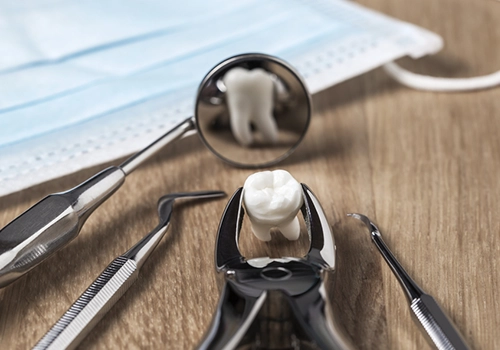Tooth Filling
Tooth fillings are like patches for your teeth. They are used to fix holes or gaps caused by decay, breakage, or damage. These fillings are crucial for fixing cavities or chipped teeth, which can get worse over time. The sooner you spot and fix them during regular check-ups, the better.
If you ignore these problems, they can lead to toothaches, bad breath, infections, or even make you lose a tooth. Getting a dental filling from a skilled dentist makes it last longer. Dr. Maadico is here to help you find the right choice for your dental filling.
There are different types of dental fillings, each with its pros and cons. In this article, we’ll answer all your questions about dental filling procedures and filling materials, making it easier for you to decide what is best for your teeth.
Indications for Tooth Fillings
Dentists recommend dental fillings based on various indications. Here are some common reasons why a dentist might recommend a dental filling:
Dental Caries (Cavities)
Cavities are primarily caused by the gradual decay of tooth enamel due to the presence of plaque and bacteria. Poor oral hygiene practices, excessive sugar consumption, and a lack of regular dental care contribute to the development of cavities. The interaction between bacteria and sugars in the mouth produces acid, eroding the enamel and creating voids in the tooth structure.
Symptoms may include:
- Tooth sensitivity, especially to hot or cold stimuli, as well as localized pain.
- Visible signs such as dark spots on the tooth surface.
- Bleeding gums
- Bad breath
Types of cavities
- Smooth Surface Cavities: These cavities occur on the smooth, flat surfaces of the teeth, often caused by plaque buildup and poor oral hygiene. Smooth surface cavities commonly develop on the sides of the teeth (buccal and lingual surfaces) and between the teeth (inter-proximal surfaces).
- Pit and Fissure Cavities: Found in the deep grooves and pits on the chewing surfaces of molars and premolars. These areas are more prone to trapping food particles and plaque.
- Recurrent or Secondary Cavities: Develop around existing dental fillings or other dental restorations.
- Root Cavities: Develop on the roots of teeth, often near the gum-line. Root surfaces can be exposed due to gum recession, and they are more vulnerable to decay. It is common in older individuals or those with receding gums.

Fractured or Chipped Teeth
Fractured teeth can result from various causes, including traumatic injuries, accidents, or habitual behaviors like teeth grinding (bruxism). Certain risk factors, such as weakened tooth structure due to large fillings or untreated cavities, increase the vulnerability of teeth to fractures. Additionally, engaging in activities that pose a risk to dental health, such as biting on hard objects, heightens the likelihood of chipped teeth.
When left untreated, chipped teeth may expose the inner layers of the tooth to bacteria, leading to infections or more extensive structural damage.
Tooth Sensitivity
Tooth sensitivity is often triggered by factors such as hot or cold temperatures, sweet or acidic foods, and vigorous tooth brushing. Underlying causes include receding gums, enamel erosion, or exposed dentin—the sensitive layer beneath the enamel. Sensitivity can be a warning sign of dental issues, emphasizing the need for a thorough examination to determine the appropriate course of action.
Dental fillings effectively address tooth sensitivity by sealing off exposed dentin and reinforcing the tooth structure. The filling material acts as a barrier, insulating the tooth from external stimuli and reducing sensitivity.
Types of Tooth Fillings
Dental fillings, essential in restorative dentistry, are used to address various dental issues, including cavities and structural damage to teeth. Tooth decay treatment involves replacing the decayed or damaged portions of a tooth with a suitable material, restoring its function, and preventing further deterioration.
Different types of tooth fillings exist, each with unique compositions, characteristics, advantages, and disadvantages. The choice of filling materials and techniques depends on factors such as the location of the tooth, the extent of damage, and aesthetic preferences.
Amalgam Fillings
This type of tooth filling consists of a mixture of metals, including silver, mercury, tin, and copper. Known for their durability, Amalgam fillings have been used in dentistry for over a century, particularly in back teeth subjected to high chewing loads.
Amalgam fillings are cost-effective and resistant to wear. However, their silver color may be aesthetically displeasing, and concerns about mercury content have sparked debates over their safety.

Composite Fillings
This type of tooth cavity filling is composed of a tooth-colored mixture of resin and glass or quartz filler particles. Composite fillings can be matched to the natural color of the teeth, making them a popular choice for front teeth and cosmetic considerations.
Composite fillings offer excellent aesthetics and bond directly to the tooth, requiring less removal of healthy tooth structure. However, they are more susceptible to wear and staining compared to amalgam and may be more expensive.
Glass Ionomer Fillings
These fillings are made of acrylic and a specific type of glass, providing a translucent appearance. They release fluoride, contributing to cavity prevention, and are often used in low-stress areas or for pediatric patients.
Glass ionomer fillings offer a natural appearance, fluoride release, and the ability to bond to the tooth. However, they may be less durable than other types of fillings and more prone to wear and fracture over time.
Gold Fillings
Gold inlays/onlays are crafted from a mixture of gold and other metals. Known for their high durability, they are often used in areas with heavy chewing loads.
Gold fillings are well-tolerated by gum tissues and exhibit a precise fit. However, their conspicuous gold color and higher cost make them less popular, especially for visible areas in the mouth.
Indirect Tooth Fillings
Unlike direct fillings that are placed directly into a cavity during a single dental visit, indirect fillings are fabricated outside the mouth and then cemented or bonded into place. In the first appointment, the dentist removes the decay or damaged portion of the tooth. While the permanent indirect filling is being fabricated, a temporary filling may be placed to protect the tooth.
In the next appointment, the temporary filling is removed, and the dentist checks the fit and color of the permanent indirect filling. After ensuring satisfaction with the fit and appearance, the inlay or onlay is permanently bonded or cemented onto the tooth.
There are two main types of indirect tooth fillings:
- Inlays: This type of indirect filling is used when the damage or decay is within the cusps (the raised points) of the tooth. They fit within the prepared cavity and are typically made of materials like porcelain, composite resin, or gold. Inlays offer a conservative approach, preserving as much natural tooth structure as possible.
- Onlays: Also known as partial crowns, are used when the damage or decay extends to one or more of the cusps. They cover a larger portion of the tooth and are designed to restore its shape and function. Onlays can be made from various materials, including porcelain, composite resin, or gold.

Temporary Tooth Fillings
Temporary fillings are short-term solutions used to protect the tooth, prevent sensitivity, and maintain function until a more comprehensive dental procedure, such as placing a permanent filling or crown, can be performed. They are commonly used after cavity preparation, in emergencies, or following root canal treatment.
Over-the-counter temporary filling materials are also available for temporary relief at home, but they are not substitutes for professional dental care as they fracture or fall out within a month.
The Dental Filling Procedure
- Your dentist will begin by examining your teeth visually to detect cavities. X-rays may be taken to get a more detailed view of the extent of the decay.
- Before the filling procedure begins, the dentist will typically administer a local anesthetic to numb the area around the affected tooth. This ensures that you don’t feel pain during the procedure.
- The dentist will use a drill or laser to remove the decayed portion of the tooth to eliminate all traces of decay and create a clean surface for the filling.
- After removing the decay, the dentist will shape the tooth to create space for the filling material.
- Based on factors like the location of the filling, your budget, and aesthetic preferences, your dentist will discuss the options with you and help you choose the most suitable material.
- The chosen filling material is placed into the prepared tooth, and the dentist will carefully shape and polish it to ensure a natural and comfortable fit.
- If a composite resin filling is used, it needs to be cured (hardened) with a special light. This process helps the material bond securely to the tooth.
- After placing tooth fillings, the dentist will check your bite to ensure it is comfortable and make any necessary adjustments.
- The dentist will polish the filled tooth to smooth out any rough edges and make it blend in with the surrounding teeth.
- On average, a straightforward filling typically takes about 20 minutes to an hour.
Aftercare and Recovery
Recovery time after a dental filling for tooth decay and cavity repair is typically minimal. Most individuals can resume normal activities immediately after the procedure. It’s important to follow proper aftercare guidelines to maintain the health of your teeth:
- Wait until the numbness in your mouth wears off before eating. This helps prevent accidentally biting your cheek or tongue.
- In the first few hours after the procedure, stick to soft foods.
- Avoid very hot or very cold foods and drinks, as sensitivity may be heightened.
- Continue with your regular oral hygiene routine, including brushing and flossing. Be gentle around the filled tooth, especially if there’s any tenderness.
- It’s normal to experience some sensitivity to hot, cold, or sweet foods for a few days after tooth filling.
- For a day or two after the procedure, avoid chewing on hard or sticky foods that could potentially dislodge or damage the filling.
- Drink plenty of water to stay hydrated.
- If you notice a sharp edge, crack in a filling, or any unusual symptoms, such as persistent pain, swelling, or signs of infection, contact your dentist promptly.

Final Takeaway
Maintaining good oral health involves prioritizing regular dental check-ups. Swiftly addressing issues like decay with routine procedures such as tooth filling is crucial. For the best results and peace of mind, consult a professional dentist to guide you in selecting the right types of tooth fillings and implementing proper care, ensuring the preservation of a strong and healthy smile.
Our experienced dentists on Dr. Maadico’s Medical Department, guide you to the right choice for your dental filling, ensuring durability and expert craftsmanship.
Dr. Maadico’s Medical Department simplifies the decision-making process, providing comprehensive information on various filling types and connecting you with experienced professionals.
Take the first step towards a brighter, healthier smile – your teeth deserve the best care!
Get a Free Consultation
FAQ
- What causes tooth fillings to fall out?
Several factors can lead to a new tooth filling falling out, including inadequate bonding, improper placement, chewing forces, or degradation over time.
- How long do tooth fillings last?
The lifespan of tooth fillings can vary depending on the material used and how well they are cared for. On average, tooth fillings can last 5 to 15 years.
- Can tooth fillings be replaced?
Yes, tooth fillings can be replaced if they become worn, or cracked, or if decay develops around the filling.
- Are tooth-colored fillings better than silver amalgam fillings?
Tooth-colored fillings, also known as composite resin fillings, are aesthetically pleasing as they blend in with the natural tooth color. However, silver amalgam fillings are known for their durability and strength.
- Are tooth fillings painful?
The procedure for placing tooth fillings is usually painless, as local anesthesia is used to numb the area before the treatment.
- How can I take care of my tooth fillings?
Taking care of tooth fillings involves maintaining good oral hygiene practices, such as regular brushing, flossing, and visiting your dentist for check-ups and cleanings. Avoid biting on hard objects or using your teeth as tools to prevent damage to your fillings.
- Are tooth fillings in Iran of high quality?
Yes, tooth fillings in Iran are of high quality. Iran has a well-developed dental healthcare system with skilled and experienced dentists. The dental materials used in Iran also meet international standards, ensuring the durability and effectiveness of tooth fillings.


